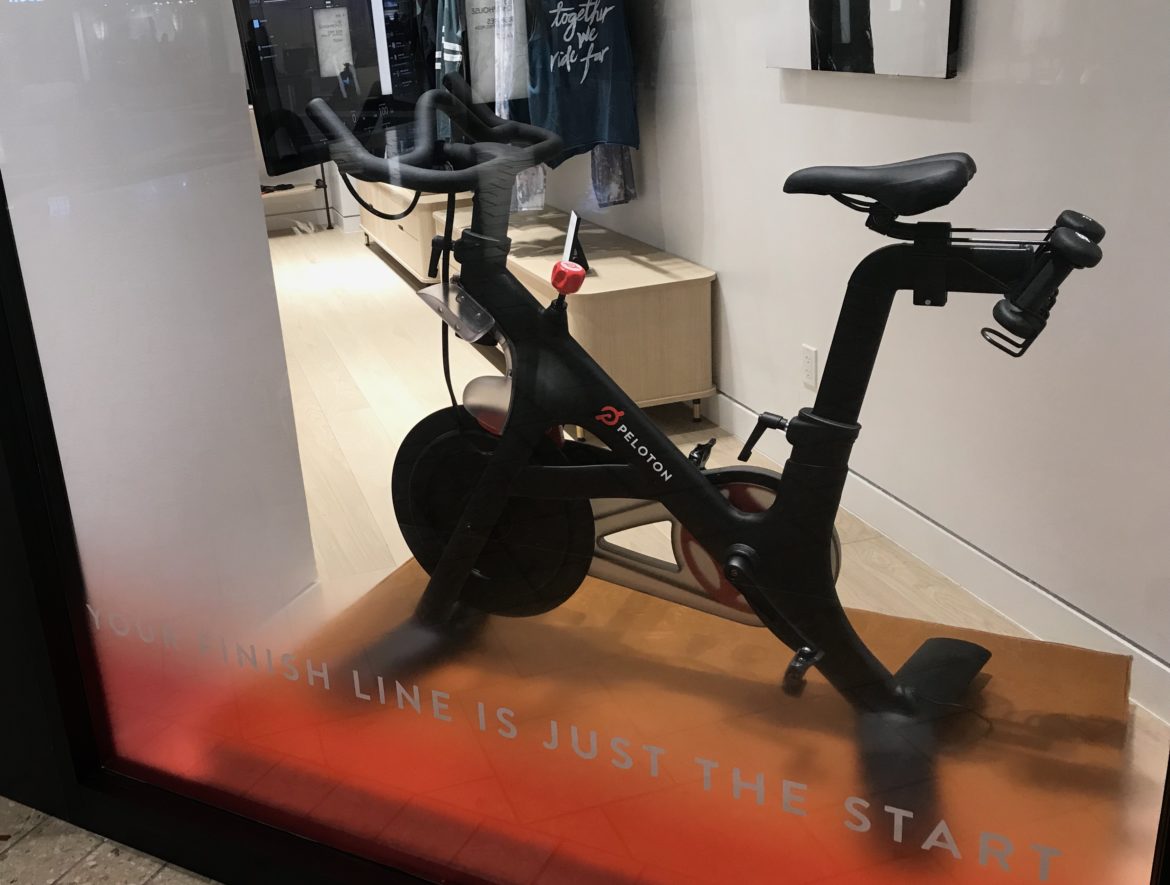Editor’s Note: “The Balance” is a regular column written by Matt Miller. While Matt is a staff writer for Singletracks, any opinions expressed in this column are his alone and do not necessarily represent the opinions of Singletracks.com.
Every time I turn on Hulu lately, which is usually the one time during the day when I spend an hour not thinking about bikes, an advertisement reels up, and gets me upset about something that has to do with bikes.
The opening sequence has a successful, young professional, pretty or handsome, in their 30s, intensely exercising on an indoor bike. Their brows are dripping with sweat as they pump and sprint, eyes locked on the monitor like a snake about to strike a rabbit. It appears the stress from their daily lives, which are most likely spent at a desk in a high rise urban building, is transferred into the pedals and away from their cluttered minds.
Jay-Z raps about achievement and climbing socio-economic barriers in the background of one ad. In another, a husband and wife sneak off and use the bike before the other awakes, showing that the bike is time-efficient, quiet, and enthralling. A young mother becomes stronger and more attentive in another ad, by way of pedaling indoors.
It’s no coincidence that the marketing for the Peloton is especially heavy this time of year. Gift-giving season just passed and that’s always followed by a season of tuning up the body. Businesses are making their push for sales at the beginning of the year and it feels like a first and last-ditch effort simultaneously.
[see_also id=’252517′]
The Peloton isn’t another fitness gimmick like the Shake Weight, or a fad like the grapefruit diet or plus-size tires. Indoor bikes aren’t a trend, either. They’ve been around for decades and will continue to have their place, along with indoor trainers, in gyms and basements across the world.
Where the Peloton seems to differ in their approach is the sheer amount of money they can throw into ad campaigns thanks to the company’s $4B valuation. This gets weird because mega-companies like Peloton can bring their perception of cycling to mainstream America. Judging by the recent advertisements, Peloton’s presentation is not much different than how cyclists (both road and mountain) are already perceived by the majority of Americans.
That perception is one that holds strong from the Armstrong-era of road biking, where anyone who rides a bike is rich, elitist, and uses a bicycle solely as a means for fitness or to beat other people within a competition. Mountain biking doesn’t have a comparable icon in mainstream America, probably to its benefit.
https://www.instagram.com/p/BrlwTUoI0vt/
To dive into the nature of the Peloton a little bit more, it goes like this: For as little as $2,245 — or $58 a month for 39 months — you too can own a Peloton, an indoor exercise bike with a 2’x4′ footprint, that connects to a bottomless page of online content displayed on a 22-inch monitor, which you can start on your own schedule, or plug into a live class, (there are 14 per day), hosted by one of a dozen or so Peloton instructors. A “top DJ” spins records next to the instructor playing every Rihanna x David Guetta song ever made, to energize those in attendance to “pump it, baby!” Their efforts are measured on a live leaderboard so that riders can compete against one another in real-time, like Strava, only in an artificial ride environment. You can sweat, break virtual records, and make virtual friends, all from the comfort of your virtual mountain- er, home.
To me, it comes across as phony, and artificial, and it’s bad for the perception of bikes across the world. That perception, to elaborate a little bit more, is that in mainstream America, when you reach adulthood, real bikes are not for you anymore. As an adult, the only appropriate way to use a bicycle is for fitness, not for fun. Fun is reserved for activities like brunch, board game night, and watching the game with friends.
It is also an incentive to become more isolated. At an astronomical price of close to two-and-a-half-thousand dollars, you can instead get a decent, brand new mountain bike, or a killer, used mountain bike that will challenge you in real environments, humble you, and make you a better person. I know I don’t have to explain this to most readers on Singletracks. But, from a social perspective, it doesn’t really seem like the benefits of the Peloton differ all that much from playing Dance Dance Revolution on the carpet of your living room floor.
This is also a weird sell to those who are already a little too plugged in to social networks and email, considering that the marketing is centered around escaping from daily life. You know how Strava can make you feel good or bad sometimes, but it doesn’t really matter because at least you got outside and felt the sun on your skin, mud on your shins, or dirt in your teeth? Well, take away all those real elements and you’re left with a bike that doesn’t actually go anywhere or seem to add anything, except for results that are based around where you fit in a “leaderboard.”
My beef isn’t with riding indoors, spin classes, Zwift or anything that makes it easier for people to exercise when they don’t have time or it isn’t fun. But, to see such a huge push from a company that’s trying to sell the benefits of riding bikes without the soul, well I guess I’m just a little bit jealous that the rest of the bike industry doesn’t have that kinda dough.













42 Comments
Jan 19, 2019
Jan 18, 2019
Jan 19, 2019
X Bike
No monthly charges
Jan 18, 2019
The cost for the bike itself is pretty outrageous, considering everytime I attend an encore class there are dozens of people on at all hours of the day - all who are paying some monthly subscription fee (unless you're at the Y or gym I guess). That's a lot of money on subscriptions, you would think that would offset the price of the bike. Oh wait, but then they had to go an open showrooms = $$$. Sigh, I feel like I'm in the wrong industry here. Good thing there's always a Live DJ ride with Robin to cheer me up ;)
Jan 18, 2019
Jan 20, 2019
Jan 21, 2019
Feb 2, 2019
If I am reading your column correctly, your argument is that Peloton is only reinforcing the image that bikes are for exercise instead of visceral enjoyment of the world around you. You argue that Peloton is only reinforcing the belief that bikes are a form of exercise equipment, and that this form of exercise must be fit into the spare moments of your life, as you spend the rest of your time going about the “real” business of living.
I agree 100% with your assessment that this type of thinking is seriously fucked up. But I don’t take it to be an issue with the bike industry today, or with Peloton as a company. As others have pointed out, they are successfully making money by taking this approach.
Instead, I take this as just one more indication of how seriously screwed up American culture is today, and how our society could very well be spiraling down into one of any number of dystopian science fiction novels or movies in which the characters live their lives completely in virtual reality.
To combat this dystopian future, instead of viewing “fitness” as the goal, I have chosen to view “time spent outside” as the goal in my own life. I’ve been conducting a personal experiment called “Outside 365” in which I am active outside every day, without excuse. Today will mark 191 consecutive days of being outside and active. I’ve also been reading the scientific literature (or at least summaries thereof) about how time spent in nature benefits us, and how time spent in indoors damages us. The science is compelling, to say the least.
So let me try to wrap this comment up.
In your post, you said, "My beef isn’t with riding indoors, spin classes, Zwift or anything that makes it easier for people to exercise when they don’t have time or it isn’t fun.” Well, I’m going to go there. My beef IS with spending time inside, instead of spending time out in the real world actually experiencing the planet, the trees, the grass, the people, the clear blue sky, and yes… even the cold and the wet. We spend so much time staring at screens whether we want to or not—our jobs all mandate it. Why would we want to sell our soul to yet another screen, when insead we could be having experiences in the REAL world that are now, sadly, only enjoyed by a fraction of the population?
Parting shot: I’m sick of people saying that they “can’t get outside and ride” in the winter. You can literally buy a fat bike and a headlamp for much less than $1,000, use some warm clothes you already own, and go for a ride any time of the day or night, and in any weather conditions. Will it always be on singletrack? No, but you can always ride.
There, case closed.
Feb 4, 2019
Jan 19, 2019
Jan 24, 2019
I once trained on my road bike while attached to the cyclops while watching all three Lord of The Rings movies...I must have had a screw loose!
Jan 18, 2019
I have a lot of respect for what Peloton is doing, and clearly a lot of people find value in the bikes and the programming. If the alternative is an old-school exercise bike or indoor trainer, I'll take a Peloton any day!
Jan 18, 2019
Jan 19, 2019
Jan 19, 2019
Jan 18, 2019
Jan 18, 2019
Jan 20, 2019
Jan 21, 2019
Jan 21, 2019
It's hard to argue with the logic of going that route: save some time, avoid the cold. But it does seem like community suffers a bit.
Jan 18, 2019
Not everyone's so lucky - go into google maps and look at your typical american town. Flat, no green, a suburban street grid stretching for miles in every direction. My brother and sister in Norfolk VA are hardcore cyclists and skiers, and they got a Peloton spin bike to keep them from going insane. I'm happy they have it.
I think the popularity of Peloton and spin is a good thing - people are interested in cycling. The bad thing, and the reason that people don't want to ride outside, is that its unsafe or unfun where they live. As cycling infrastructure and bike paths and single trails are built we'll get some converts. Even if we get a 10% conversion rate from indoor cycling to road and mountain biking, that's still a big chunk and a big group of people that could potentially add to cycling advocacy.
Jan 19, 2019
Personally, I think the Peloton program is both a great value and terrific training.
Although the Peloton’s power output is determined by an algorithm, it pretty well matches the Stages power meter on my road bike at similar exertion levels. They offer FTP based Power Zone classes where each rider’s personal zones (1-7) are displayed on the monitor, so, rather than saying “increase resistance to 45” the instructor says, “go to your zone 4.” The way they’ve been able to continually upgrade the experience simply by pushing out an upgrade to the monitor is astounding and is a prime reason why most people use their Peloton bikes rather than convert them to coat racks.
I haven’t even touched on the yoga, full body workouts, etc that come with the $39 monthly fee or that everyone on your house can use the bike and all of the other exercise offerings for the same one charge of $39.
Finally, the customer service is spectacular. Peloton has replaced my touch screen monitor, replaced my heart rate monitor, replaced my flywheel bearings and credited me for some monthly fees, all at no cost to me since I was under the 3yr extended warranty.
Look, I own a lugged steel bike with carbon wheels, SRAM Red 22 group, etc. that is an absolute joy to ride alone or with friends outside. However, the convenience of getting a kickass workout in my home on my Peloton, is fantastic.
And it’s not the least bit lonely. Last Saturday, I did a live 90 minute Power Zone Endurance ride with 2000 other people, 71 of whom I follow. We were encouraging each other throughout the ride via “high-fives” we could send through the touch screen.
There is a Peloton Facebook group filled with road riders like me who do gran fondos together during the summer/fall and ride our Pelotons together at other times. I’m not sure that your limited experience with the Peloton bike, instructors, and fellow riders is representative of how those of us with a longer history feel about it.
It’s pretty great.
Jan 20, 2019
Peloton is a high quality, engaging, and socially media driven cycling/fitness experience. I find it far more convenient that a gym spin class, far safer than riding on the road particularly in dark in the NW after working hours, very challenging and very effective.
Peloton as a brand has been very smart. They have included NBC as an early investor, notice how most of the Peloton ads you see are on NBC? They have created a buzz, experience and community and a pre-IPO valuation that is impressive and material. It is not mountain biking but is very good at what it is.
Why are you knocking it? There is a Peloton MTB community which is more supportive and encouraging for the demographic the mountain bike industry should be interested in cultivating than IMBA or other groups I have seen. MTB'ing should be inclusive, not exclusive. If Mountain Bikers augment their fitness with a Peloton what is the harm?
Jan 21, 2019
Jan 18, 2019
Jan 19, 2019
Traffic, wind, cold temps, etc.
Just get outside and ride!
Dress appropriately. Get your hands on a cheap XC bike with all terrain tyres, learn to ride on ice (go slower, be careful when cornering and braking ) and buck up and get outside.
It won’t be fun at first but after the first few rides you’ll be glad you did.
Ride or die!
Jan 19, 2019
Jan 18, 2019
Jan 21, 2019
Jan 21, 2019
Jan 18, 2019
Our local YMCA has a pair of peloton bikes. Its rained for weeks and the trails are closed a lot. I can drop my kiddo off at swim practice ans spin on the Peloton (I like the Guns N Roses ride) for an hour. When the trails dry out I haven't lost any fitness. So for us Peloton is pretty great.
Jan 18, 2019
Jan 18, 2019
Jan 18, 2019
Jan 18, 2019
https://finance.yahoo.com/news/peloton-ceo-says-sales-increased-raised-prices-2245-exercise-bike-132256225.html
Peloton CEO John Foley tells Yahoo Finance the profitable fitness startup saw sales of its in-home exercise bike actually increase after it raised the price to $2,245.
“It was interesting psychology that we teased out,” Foley recalls. “In the very, very early days, we charged $1,200 for the Peloton bike for the first couple of months. And what turned out happening is we heard from customers that the bike must be poorly built if you’re charging $1,200 for it. We charged $2,000 dollars for it, and sales increased, because people said, ‘Oh, it must be a quality bike.’” ......
Jan 18, 2019
Jan 18, 2019
Jan 18, 2019
Jan 19, 2019
I don’t know if you’ve priced Soul Cycle lately, but it would be way more than that and we wouldn’t own the bike or have the convenience of riding it whenever we want and without having to drive in snow.
They also hold their value surprisingly well. If we decided to sell it, we could likely get $1,700+ for it.
Jan 19, 2019
Jan 24, 2019
Mar 3, 2019